NATO Caspian Sea & Russia
Black Sea
The Black Sea connects varied countries and cultures and is ringed by Bulgaria, Georgia, Romania, Russia, Turkey and Ukraine and serves as a vital maritime transport gateway to the rest of the world. Its ports handle millions of tonnes worth of goods every year including wheat .
Black Sea Straits
The Bosphorus and Dardanelles straits, which connect the Sea of Marmara to other bodies of water, are governed by the Montreux Convention. This treaty regulates the passage of ships through the straits, including warships belonging to nations with a Black Sea coastline and even those without. After Turkey’s closure of the Turkish Straits entering the Black Sea, Russia’s Caspian Flotilla serves as the only means of reinforcing the Black Sea Fleet. Realising how vital the Volga Don canal is, Moscow announced a USD $1 billion investment to modernize its inland waterway connecting the Caspian and Black Sea. Theoretically this is likely to make the canal dependable to move military supplies and equipment between the Caspian and Black Seas and enhance trade volumes with Iran.
Turkey & Montreux Convention
This agreement, signed in 1936, gives Turkey control over the Black Sea Straits, and also establishes rules for freedom of navigation for commercial vessels and limits on the passage of warships, particularly during peacetime. While the Montreux Convention primarily focuses on the straits, the Sea of Marmara itself falls under Turkey’s sovereignty and is managed by Turkiye.
Caspian Sea or Inland Body of Water
The Caspian Sea is a vast body of water covering 371,000 square kilometres with an average depth of 211 meters and a maximum depth of over 1 kilometre. The question arises as to what could be the implication of not being categorised as a sea or a lake? There is a strong viewpoint that the United Nations Law of the Sea does not apply to the Caspian Sea. By legal precedent, a Sea cannot be claimed by any single nation, and any maritime country’s fleet is free to use it within limitations stipulated by the UN or IMO. However, a lake can be claimed by a single or group of nations, and passage is not necessarily available to all. This may lead to a territorial dispute as the Caspian Sea hasn’t been demarcated.
Cities on Coastline of Caspian
The capital of Azerbaijan – Baku is located on the coastline and derives much of its economy from fishing and maritime industries. The Iranian capital of Tehran is roughly 100 km south of the shore. The coastline is dotted with numerous cities, including old naval forts. Cities of Makhachkala in Russia, Astrakhan and Grozny are located along rivers that feed on the Caspian Sea, Rasht and Sari in Iran, Turkmenbashi and Balkanabat in Turkmenistan, Atyrau, Aktau, Zhanaozen, and Fort-Shevchenko in Kazakhstan, Baku, Khachmaz, Sumqayit and Astara in Azerbaijan.
Navies of the Caspian Sea
Russia maintains a 28 strong Caspian Flotilla which dominates comprising 2 Gepard Class frigates (damaged in a Ukrainian attack) , 16 corvettes and minesweepers. To have an understanding of the magnitude of expenditures involved in maintaining a naval ship it is almost US $ 175 million per ship 11661E (Gepard 3.9 batch II) and extends upto US $ 350 million per ship considering the price of ammunition and maintenance packages as per an agreement between Vietnam and Russia. The Iranian Northern Fleet, forming its 4th Naval Region, is led by Moudge Class frigate IRINS Deylaman (F78) with the 4 Sina Class fast attack craft armed with C-802 anti-ship missiles, which participated in a recent sea exercise. Together, Russia and Iran are much stronger than Azerbaijan, Kazakhstan and Turkmenistan, however lately Azerbaijan have been upgrading its navy reportedly with Israeli and Turkish assistance and operating Triton Class midget submarines, only such craft stationed in the Caspian.
NATO Connectivity – Caspian & Black Sea Seas
Russia’s large scale invasion of Ukraine in the year 2022 led to a renewed focus on the geopolitical importance of the Black Sea. Previously the North Atlantic Treaty Organization (NATO) ignored Russia’s use, often in coordination with Iran, of the Caspian Sea to advance its war aims in Ukraine. The Caspian Sea offers Russia a strategic depth to strike targets far afield in a relatively safe manner, strategically viable for Russia to reinforce its Black Sea Fleet, also serving as a transport conduit and allowing Iran to deliver military assistance to Russia for use against Ukraine. One of the two canals connecting the Caspian Sea to the outside world is the Volga-Don Canal which links it to the Black Sea via the Sea of Azov. This canal is 63 miles long and connects the Don and Volga Rivers. Its primary purpose is commercial transport. Surreptitiously , during the spring and summer months, when the canal is not frozen, Russia uses it to move warships and military supplies between the Caspian Sea and the Black Sea. Ships from Russia’s Caspian Flotilla have played a direct role in supporting Russia’s invasion of Ukraine since 2022.
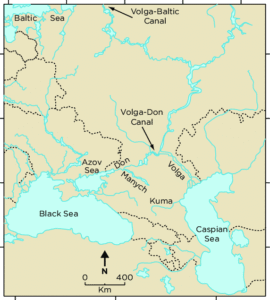 Credit;Research Gate
Credit;Research Gate
Complacent European Neighbourhood Policy
Both the Black and the Caspian Sea regions are covered by the European Neighbourhood Policy (ENP) instrument of the European Union (EU) and at EMSA, by the BCSEA II technical assistance project implemented by the Agency. The BCSEA II brings together European, national and international stakeholders with the aim of raising maritime safety, security, and protection of marine environment standards in the Black and Caspian Sea basins. The BCSEA II Action covers the following countries of the seas as Beneficiaries:
(i) Black Sea region comprising Georgia, Republic of Moldova, Ukraine, and Türkyie
(ii) Caspian Sea region assistance limited to capacity building and CSN services namely Azerbaijan, Iran, Kazakhstan, and Turkmenistan
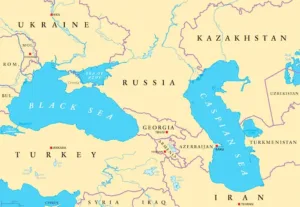 Credit ;wikipedia
Credit ;wikipedia
Azerbaijan & Caspian Sea
The Caspian covers 371,000 sq.km and is considered the largest inland lake or water reservoir on account of inflow from several major rivers. It has an average elevation of 28 m below the mean sea level. The seabed of the Caspian Sea is varied in depth and sub-surface features and its depth increases towards the South. The North Caspian region covers less than 100,000 square kilometres and has an average depth of around 10 meters, with a maximum depth of 20 meters. The South Caspian region is considerably deeper, with an average depth of over 1,000 meters , ideal for lurking submarines. Due to internal currents, marine species from the Caspian Sea penetrate other water bodies where they become invasive. Many species have been driven to extinction or endangerment owing to excessive hunting. The Caspian seal, native to the region, numbers around 100,000 today, when there were initially over 1 million 3 decades ago.
Caspian Sea Resources
The countries bordering the Caspian Sea depend on its mineral resources including oil and natural gas reserves. This contributes to an estimated 10% of their GDP and around 40% of all exports. These countries organized the Caspian Economic Forum in 2019 to strengthen their inter-governmental relations and improve coordinated efforts in diverse fields such as infrastructure, oil & gas, tourism, trade and transport. The leading nations are Azerbaijan and Kazakhstan, interested in attracting Foreign Direct Investment (FDI) to their energy sector. Iran has an ample supply of crude oil and is ranked 2nd in the world in terms of reserves. It has an estimated 137 billion barrels of crude oil and 988 trillion cubic feet of natural gas. Russia is ranked 2nd in the world for oil and natural gas production.
The average output from the Caspian Sea is 1.5 million barrels per day with Kazakhstan producing 55 % and Azerbaijan 20 % of the production. Exploration of the seabed and construction of oil wells can be traced back to the late 19th century in the Bibi-Hey bat Bay of Azerbaijan. The oil fields of Baku have produced ample supplies of oil, especially under the erstwhile USSR government. A oil contract in 1994 led to the setup of the Baku-Tbilisi-Ceyhan pipeline transporting Azeri oil to Ceyhan.
Kazakhstan Strategic Caspian Sea Hydrocarbon Routes
Most of Kazakhstan’s oil production is exported through the Caspian Pipeline Consortium (CPC) network which pipes through Russia and terminates at Novorossiysk on the Black Sea. Russia utilises the CPC network to export its Urals oil from Omsk and Kazan through Kazakhstan to China. Uncomfortable in this mutual inter-dependency, Kazakhstan is developing its own capability to export instead across the Caspian from Aktau to Baku, through shallow draft tankers manufactured with Abu Dhabi Ports Group specially for Caspian operations. From Baku the Kazakh oil can then flow through the Baku-Tbilisi-Ceyhan pipeline avoiding Russian territory.
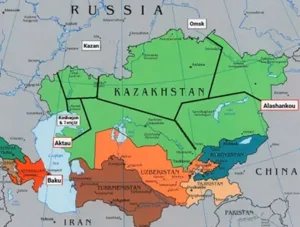 Credit; Azerbaijan Central Asia Net
Credit; Azerbaijan Central Asia Net
Conflicts in the Caspian Sea
Along the vast coastline of the Caspian Sea spanning 7,000 kilometres, 5 nations exist. In the North lie Russia and Kazakhstan and in the South Iran,Turkmenistan and Azerbaijan. The longest border is with Kazakhstan at over 1400 km, followed by Turkmenistan, Azerbaijan, Russia and shortest border is of Iran at 728 km. Uzbekistan, Armenia, Georgia and Turkiye are a few hundred kilometres from the Caspian Sea. Mineral resources, including oil and gas reserves need to be demarcated to prevent tensions over excess mining. The main conflicts are between Iran, Azerbaijan, and Turkmenistan and Azerbaijani research vessels claim to have come under fire from both during routine expeditions. Iran has repeatedly claimed illegal incursions, while Turkmenistan alleges Azerbaijan has pumped more than the agreed share of oil from a standard subsea deposit. The 5 nations have naval fleets active in the region to safeguard their national interests. Iran has proposed the solution of an equal 1/5th share to each nation which has been rejected as Iran has the smallest coastline but will receive an unduly large percentage of the resources.
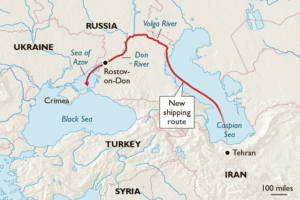 Credit ;The Times
Credit ;The Times
Volga-Don Canal Russian Inland Waterway linkages
Russia controls the only access to the Black Sea through the Volga-Don canal. This is an inland waterway linking the Black, Caspian, Baltic, and White seas realized with the opening of the Volga-Don Canal as far back as 1952. The Volga–Don Canal provides the most direct navigable connection between the Caspian Sea, Sea of Azov, Black Sea & hence the oceans. This route is especially used for project shipments & Out of Gauge goods . The Volga-Don Canal retains significance for the economies of southern Russia, South Caucasus and Central Asia. Lenin Volga–Don Shipping Canal is a ship canal in Russia connecting the Volga and the Don at their closest points with a length of 101 km, and 45 km of which is through rivers and reservoirs and a registered depth of not less than 3.5 meters, although silting and the absence of regular dredging mean that in places it is likely much less than that. Coinciding with the end of the Soviet Union a short-lived effort was made to construct a deeper channel alongside the existing one . The Volga-Don Canal’s condition is not good due to neglect and the aging canal is deteriorating. Presently it is too shallow and has too many locks to be able to handle larger ships and is perceived as a transit bottleneck for Russia . Moscow’s present inability to secure external financing for inland waterway projects leaves it in a bind. The Volga River constitutes the primary component of the Unified Deep-Water System (UDWS) of European Russia, which connects the Caspian Sea and the Sea of Azov. Following the Russian invasion of Ukraine the significance of the Volga River in this waterway shifted. Concurrently the efforts of states bordering the Caspian Sea to expand their trade routes increased. The Caspian Sea is connected to international waters through the Unified Deep-Water System of European Russia (UDWS) , a system of inland waterways of Russia, connecting the White Sea, the Baltic Sea, the Caspian Sea via the Sea of Azov to the Black Sea through the Neva River, Lake Ladoga, Svir River, Lake Onega, White Sea-Baltic Canal, Volga–Baltic Waterway , Moscow Canal, Volga River, Kama River, Volga–Don Canal and the Don River. Russia owns 16 % of global navigable inland waterways followed by China at 18 %. On average, UDWS is responsible for 70% to 75% of all domestic cargo and transports via Russian inland waterways. The Volga River, stretching over 3,500 km, is the longest river in Europe and a major element of UDWS. With an average discharge of 8,100 m3 /per second at Volgograd the river is also the primary source of water for the Caspian Sea which has witnessed a significant decline in its water level in recent years, threatening the transport capabilities of Russia and Kazakhstan. . The tiny but strategic Volga-Don Canal connects up the two river systems with a 63-mile waterway allowing small freighters to navigate between the Caspian and the Sea of Azov onwards to the high seas . A series of 13 locks carry marine traffic up and over the gentle rise between the two waterways. The Soviet Volga-Don-class freighters, built precisely for the canal’s dimensions, an icon of Russia’s inland trade, remain limited to a draft of 12 feet and a maximum load of about 5,000 tonnes and 3,000 tonnes in shallow sections of the Volga and Don. Wintertime navigation usually ends in December when the canal freezes over.
Russia Iran Armament Trade along Waterways
This is limiting for the burgeoning trade between Russia and Iran, which connects in part via a trans-Caspian route. Russia plans to spend $1 billion improving inland connections to the Caspian including removing impediments to shipping on the Volga-Don complex. Shipping between the mouth of the Volga and Iranian ports at the southern end of the Caspian is increasing in volume as Russia’s inland waterway network feeds this growing trade. A sizeable chunk of the annual $ 5 billion trade between the two countries is said to be in the form of armaments. Iranian arms dealers are reportedly supplying Russia with hundreds of so-called “suicide” drones, which Russian forces are using en masse to target Ukraine’s power infrastructure. In return for this relatively simple yet desired technology, Russia is believed to be supplying Iran upgraded military systems, including helicopters and potentially the next-generation Su-35 fighter. US intelligence understands that Iran had requested Russian help with its nuclear program and it is unclear whether the aid would be for strictly civilian purposes.
Volga–Don Canal is Navigable 200 Days
As of 2019, Russia had 101,500km of registered inland waterways, of which 50,000 km were navigable. Due to underinvestment and insufficient funding in waterway infrastructure, the standardized shipway dimensions shrank by 30 % between 1990 and 2019. In 2019, the inland fleet consisted of 11,700 self-propelled and 5,300 non-self-propelled vessels a significant declines by 17.4% among self-propelled vessels and 34% among non-self-propelled vessels attributable to underinvestment . The UDWS connects major Russian cities, including St. Petersburg, Moscow, Kazan, Nizhny Novgorod, Volgograd, Rostov-on-Don and Astrakhan. The theoretical guaranteed depth throughout the UDWS ranges between 4.0 meters and 4.5 meters, allowing not only river vessels and river-sea class vessels but also sea-going vessels, warships and even (surfaced) nuclear submarines to pass through it. The USDW spans 101 km and comprises 13 canal locks, 3 pumping stations, 22 navigation channels and 2 bulkhead gates. Since the Don River is at an elevation 44 meters higher than the Volga River, vessels must make this change when traveling up or down. Although the canal can support vessels up to 5,000 tons shallow parts of both rivers are currently limited to 3,000 tons which can be improved to 6,000 tons with additional investment . The Volga–Don Canal is navigable for around 200 days a year and usually frozen from November to April. The internal waterways of Russia, of which the UDWS represents a significant component, have historically played a relatively minor role in Russia’s overall inland transport, especially since the collapse of the Soviet Union. According to Russian government data, the volume of cargo transported along the country’s inland waterways in 1988 was 582 million tons that fell to 100 million tons in 1996. The transport volume improved steadily from 1999, reaching 136 million tons and 30 million passengers in 2004. Since then inland water transport volumes have fluctuated between 110 and 150 million tons. Landlocked countries bordering the Sea namely Turkmenistan, Kazakhstan, and Azerbaijan connect with other nations through the Black and Baltic Seas depending on free passage through Volga River in Russia. Allowing of free access on Russia’s main trading route will result in suffering of congestion and vessel inaccessibility to Russian ports.
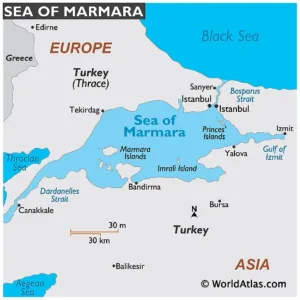 Credit;WorldAtlas.com
Credit;WorldAtlas.com
Russia Iran Maritime Axis in Ukraine War
The flow of Iranian weapons to Russia’s war in Ukraine vividly demonstrates that there is no clear geographical distinction in areas of defense. Warships operating from the Caspian Sea have launched cruise missiles against Ukraine and Russian cruise missiles from the Caspian have hit targets in Syria. The use of the Caspian for seaborne cruise missile launches gives Russia a strategic depth and a degree of protection not found in more contested areas, like the eastern Mediterranean or the Black Sea. Utilising Caspian-based naval assets to strike targets in Ukraine and Syria enables Moscow to achieve both military objectives and Caspian geopolitics. These missile strikes send a strong signal to other Caspian countries that Russia remains the dominant military and maritime player in the region.
Author ; Nadir Mumtaz
Trademark Blue Economy IPO-PK
Credit:
https://www.maritimegateway.com/russia-iran-boost-trade-movement-through-the-volga-don-canal/
http://mytrustport.com/regional-solutions/
https://www.hudson.org/security-alliances/natos-black-sea-frontier-southern-shore-caspian-sea
https://www.emsa.europa.eu/neighbours/bcsea2.html
https://www.usni.org/magazines/proceedings/1956/june/significance-volga-don-canal
https://www.marineinsight.com/know-more/10-caspian-sea-facts-you-must-know/
The_Strategic_Significance_of_the.pdf?sequence=1&isAllowed=y


Leave A Comment